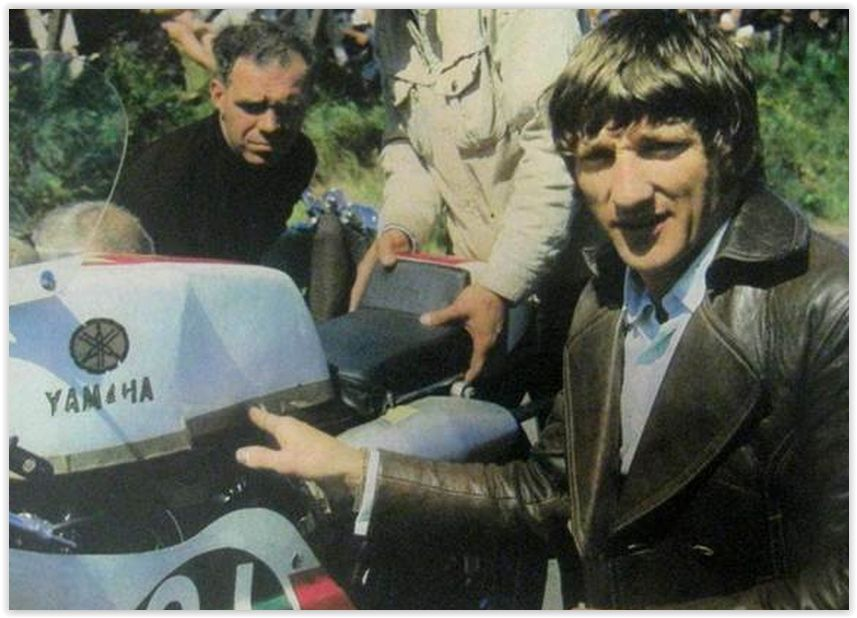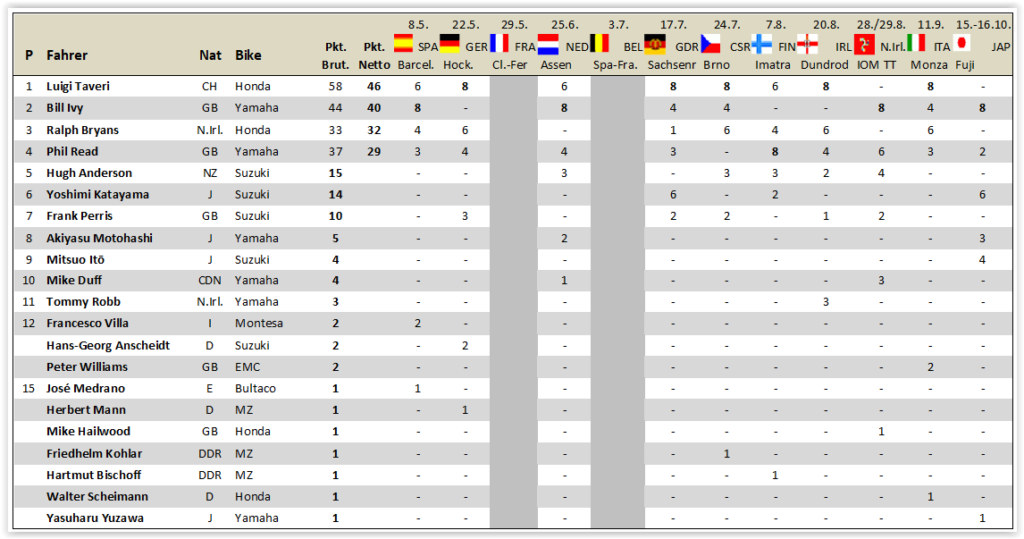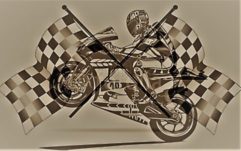
Bill Ivy as Yamaha works rider for the 1966 season
Bill Ivy made an impression on the Japanese at his first Grand Prix races last year, especially with his excellent results in the World Championship final in Suzuka. As a result, he was accepted as a regular driver in the Yamaha works team for the 1966 season. Together with his compatriot Phil Read, the Japanese competed in the 125 cm³ and 250 cm³ world championships with their two-stroke machines against a number of other manufacturers. With Honda, the strongest opponent came from their own country. The following is a list with manufacturers, classes and drivers of the works teams for the 1965 season.

Billy’s 1st season as a regular works driver got off to a furious start
Competing with Phil Read as a teammate in his rookie season was a huge challenge for Bill Ivy. His compatriot had become world champion in the 250 cm³ class for Yamaha in the two years before. But Billy didn’t give a damn about it, he was a natural and knew perfectly what he was capable of. In the very first race at the start of the season, the little Englishman achieved his first victory in the 125s on the completely new, difficult and very dangerous route from the Montjuich Park in Barcelona. He won over 17 seconds ahead of the Swiss Luigi Taveri, the Northern Irish Ralph Bryans (both Honda), teammate Phil Read and the Italian Walter Villa (Montesa). To beat the two-time world champion and team-mate right at the start of the season, Billy had probably never expected that before.

Bad luck in the 250cc race
Bill got off to a bad start in the 250s, but was already in 4th place after 4 laps. But shortly afterwards Ivy had to park his 4-cylinder two-stroke Yamaha with oily candles, bad luck! Without this mishap, a podium place would have been almost certain for him. The Italian Tarquinio Provini was still behind Ivy on lap 4. Before he later retired with a technical defect on his 4-cylinder Benelli, he was already in second place behind winner Mike Hailwood.


The second 250cc podium of his career – at the Hockenheimring
At the second race of the year, Mike Hailwood won in the 250 cc category, as he did at the season opener in Barcelona, on the vastly superior 6-cylinder Honda. In every race that the then superstar finished in the 250s, he crossed the finish line as the winner in 1966. Behind Hailwood’s team-mate Jim Redman, Ivy clinched his second podium result in the middle class, after finishing third in Suzuka last year. The 125cc race at the German GP was the prey of the two Honda drivers Luigi Taveri (SUI) and Ralph Bryans (GBR). Phil Read landed in 3rd place, while Ivy had to pit in the 2nd lap with technical problems. Billy resumed the race later, but a placement in the top 6 to secure further championship points was made impossible.

The French Grand Prix with only 3 World Championship categories
The yield of the Yamaha works team at the French GP was rather modest. Since only the 3 categories 250 cm³, 350 cm³ and sidecar were advertised in Clermont-Ferrand, there was only one race for Read and Ivy as 125 cm³ and 250 cm³ Yamaha works drivers. On the Circuit de Montagne d’Auvergne with a length of about 5 miles (approx. 8 km) there were completely unnecessary discussions between drivers and officials just before the start. The latter insisted that the drivers had to appear at the start with back numbers. Probably a French regulation from the prewar period, but just like today, even then the officials did not cover themselves with fame (editor’s note: Please take the last laps of the 8 Hours of Suzuka 2019 or the scenes before the MotoGP start 2018 in Argentina as evidence of this finding). The drivers were threatened with disqualification if they refused, despite their legitimate concerns about safety.

A weekend to forget
For Bill Ivy, this and the resulting delayed start was not the problem, but rather his 4-cylinder two-stroke Yamaha, which did not want to start when it was pushed out. In the race that followed, Billy had already worked his way up to fourth place when he overdid it in the hairpin and fell out. Phil Read again had no chance against the Hondas, but at least got 3rd place behind Hailwood and Redman. For poor Billy it was indeed a weekend to forget.

250cc Grand Prix of the Netherlands
On June 25, 1966, the fourth round of the 250 cm³ World Championship continued. This was the only category that took place in all 12 rounds of this season. In the 50s there were only 6 races this year and only five for the teams. A short time after the start of the 250cc, rain set in during the course of the race. Bill Ivy was falling further and further behind, possibly the engine of his Yamaha was already ailing at this point. In any case, the little Englishman gave up the race after 11 of 17 laps and pitted due to the severely deteriorating engine performance. Mike Hailwood took his fourth win in a row, ahead of Phil Read and Jim Redman.

125cc GP in the Cathedral of Speed – Assen
After the start of the 125 cm³ class, Bill Ivy was only fourth, behind Yamaha team-mate Read, Luigi Taveri (SUI, Honda) and Yoshimi Katayama (Suzuki). But by the fourth lap Ivy had already taken the lead. But Taveri did not give up and struggled as best he could. In the end, however, it was Ivy’s second GP victory, barely 2 seconds ahead of Taveri. The Swiss had problems in between and even had to use the grass due to an oil stain, which meant he had lost around 250 meters on Ivy. Without this bad luck he might have been crowned the winner. Read was third ahead of Hugh Anderson (NZL, Suzuki) and Akiyasu Motohashi (Yamaha) from Japan.

Belgian GP in Spa-Francorchamps
Spa gave its name to the term known today for wellness oases. British tourists have been visiting Spa since the 16th century. The name of the spa spread in the British Isles from the 17th century as a name for any type of mineral spring, after which it later became a term used worldwide. The nearby track was used for motorcycle races from 1921 and has been one of the most popular tracks since the motorcycle world championship was held from 1949 to 1990. But due to inadequate security and at the same time ever higher speeds, it ultimately flew off the GP calendar.

250cc GP of Belgium
After the no fault of her own at Hockenheim and the victory at the Dutch GP, Ivy took another break in the 125 cc class. As in France, this category was not advertised at the Belgian GP in Spa-Francorchamps. Therefore, like his teammate Phil Read, he only competed in the 250 cc run. Immediately after the start of this race, he shot into the lead, followed by Ivy and the two factory Hondas with Hailwood and Redman. However, the two Yamaha pilots had no chance against the lightning-fast 6-cylinder rockets on the fast track at Spa. In the first lap, Hailwood and Redmann passed Billy. A short time later, Ivy had to go to the pits to change candles and lost any chance of a top spot. A short time later, Read was intercepted by Mike Hailwood. Only because the Hondas were doing much worse than before in training, Phil was able to save himself from Redman on P2.


GP of the GDR on the Sachsenring and Brno – behind the “iron curtain”
The next two races took place behind the “Iron Curtain” in Eastern Europe. The routes from Brno and the Sachsenring back then had little in common with today’s circuits. At the course in Hohenstein-Ernstthal it is only today’s start-finish straight that remains from the original route. The old Masaryk ring near Brno was only near the current route. Both were highly dangerous road races with, similar to the Isle of Man, inadequate safety precautions. But at the time this was completely normal. During this time, a handful of pilots lost their lives every year in motorcycle races, whether at Grand Prix or other events.

Modest yield for Ivy
For Billy, things didn’t go quite as planned in the former GDR and Czechoslovakia. In the 250cc class he stayed without points, while Phil Read finished second behind Hailwood at the Sachsenring and in Brno. After all, Ivy was able to secure two third places in the 125cc class at both events. Every time the undisputed winner was Luigi Taveri on a Honda. Second place at the Sachsenring went to Yoshimi Katayama (Suzuki) and in Brno to Taveri’s team-mate Ralph Bryans from Northern Ireland. Read came fourth behind Ivy in the 125cc class at the Sachsenring and stayed in this category without World Championship points in Brno.

Finnish GP and Ulster GP
In Finland and at the home race at the Ulster GP, Ivy remained without any championship points to his annoyance because he could not even compete. The Englishman had crashed in a non-World Championship race at Brands Hatch and was injured. It was Phil Read who stepped into the breach in his place and secured his first and only win of the season for Yamaha in the 125cc class in Imatra. Taveri finished second ahead of Honda teammate Bryan and won the Ulster GP ahead of Bryans and Read. At the home race for the Ulster GP in Belfast in the 250 cm³ class, Read was first in the lead after the start, but a crankshaft break on his four-cylinder Yamaha destroyed his hopes shortly after the half-way point. It was a race marked by failures, in which Heinz Rosner (GDR) also retired with a gearbox damage to his MZ. The two English riders Mike Duff (Yamaha) and Stuart Graham (Honda) also retired due to a technical defect.

Triumph at home GP and podium in Monza
Bill Ivy had already fallen hopelessly behind due to his failures in Imatra and at the Ulster GP in the 125cc World Championship intermediate classification. Before the third to last lap, Taveri was leading with 50 points ahead of Honda team-mate Bryans (27), Read (26) and Billy was only fourth with 24 points. Both Yamaha works drivers came away empty-handed in the 250 race.

On the approximately 37 miles long course of the Tourist Trophy, however, Billy was fully back in the 125 cc race and clinched the first TT victory of his career. Phil Read finished second in this class called “Lightweight 125” at the TT, ahead of New Zealander Hugh Anderson on a Suzuki. Taveri was unlucky this time and only crossed the finish line in 8th place behind his teammate Bryans. But the Swiss with Italian roots struck back in the country of his origins and won an undisputed victory over Bryans, Ivy and Read. In the 250 class at the Nations GP in Monza, both Yamaha factory riders remained without points, as they did on the Isle of Man. Mike “the Bike” Hailwood won it for the tenth and final time this year on the superior 6-cylinder Honda. Heinz Rosner (GDR, MZ) was second ahead of the Italian Alberto Pagani on Aermacchi.

World Championship final in Suzuka
Even if you look in vain in the MotoGP results archive from 1966. The race for the Japanese Grand Prix in Suzuka did indeed take place, as did the season opener in Barcelona. The 250cc race was won by the Japanese Hiroshi Hasegawa on a Yamaha in front of his teammates Phil Read and Akiyasu Motohashi. This time Ivy competed for Yamaha in the 350 cc class and the 125s. He finished his first World Championship race of the 350 series behind Read in second place, ahead of Aermacchi driver Alberto Pagani. In the Championship this was enough for the 11th final place, together with his compatriot Peter Williams (AJS) and the Italian Tarquinio Provini (Benelli). The final race of the 125cc class was clear prey for the little Englishman, with which Bill Ivy finished the season as Vice World Champion. As with the 350s, he also set the fastest race lap in the 125cc GP. In the smaller class it was the third time this season and with 4 wins in 1966 Billy had more than convinced.

Bill Ivy’s successes in the 1966 season
In bold the race victories at Grand Prix events.
6. März, Mallory Park (GB), 500cc (Metisse/Matchless)
13. März, Brands Hatch (GB), 350cc (Metisse/AJS)
16. April, “King of Brands Hatch” Meeting, Brands Hatch (GB), “King of Brands Hatch” (Metisse/Matchless)
8. Mai, Grand Prix of Spain, Montjuich (Barcelona), 125cc (Yamaha)
30. Mai, Brands Hatch (GB), 250cc (Yamaha)
19. Juni, Pre-TT Meeting, Mallory Park (GB), 125cc (Yamaha)
25. Juni, Dutch TT, Assen (Netherlands), 125cc (Yamaha)
31. Aug, Tourist Trophy, Isle of Man, Lightweight TT 125cc (Yamaha)
17. Okt, Grand Prix of Japan, Mont-Fuji, 125cc (Yamaha)

125cc drivers world championship 1966
From the 10 races in 1966, only the best 6 results were counted, which is why the first 4 pilots in the World Championship table had cancellation points. After only the first 6 drivers of a race were able to win championship points at that time, here for completeness also the drivers who finished 7th to 10th in a GP (with the country codes customary at the time):
Kendo Takeshi Araoka (J, Kawasaki), Bruce Beale (RSR, Honda), Martin Carney (GB, Bultaco), Kel Carruthers (AUS, Honda), Kevin Cass (AUS, Bultaco), Jim Curry (GB, Honda), Klaus Enderlein (DDR, MZ), Lothar John (D, Honda), Seppo Kangasniemi (SF, Honda), ,Jochen Leitert (DDR, MZ), Jürgen Lenk (DDR, MZ), Ginger Molloy (NZ, Bultaco), G. Polenghi (I, Bultaco), Heinz Rosner (DDR, MZ), Dave Simmonds (GB, Tohatsu et Kawasaki), Jorge Sirera (E, Montesa), Bohumil Stasa (CS, CZ), Willi Stein (D, Honda), Vagn Stevnhoved (DK, MZ), László Szabó (H, MZ), Cees van Dongen (NL, Honda), Chris Vincent (GB, Kawasaki), Giuseppe Visenzi (I, Honda).


125cc constructors championship 1966

250cc drivers world championship 1966
From the 12 races in 1966, only the best 7 results were counted. Due to the dominance of Hailwood with the vastly superior Honda, this was of no relevance. For the sake of completeness, here are the drivers who crossed the finish line in a GP in 7th to 10th place (with the country codes customary at the time):
Rex Avery (GB, Bultco), Anders Bengtsson (S, Husqvarna), Hartmut Bischoff (DDR, MZ), Ramiro Blanco (E, Bultaco), Rex Butcher (GB, Aermacchi),Paolo Campanelli (I, Aermacchi), Martin Carney (GB, Bultaco),Cliff Carr (GB, Bultaco), Paul Conran (IRL, Bultaco),Graham Dickson (NZ, Bultaco),Peter Dürr (D, Aermacchi), Grant Gibson (GB, Yamaha), Terry Grotefeld (GB, Yamaha),Eric Hinton (AUS, Bultaco), Han Leenheer (NL, Aermacchi), Jürgen Megel (DDR, MZ), M. Meli (N.Irl., Bultaco), Gilberto Milani (I, Aermacchi), George Plenderleith (GB, Honda), Brian Richards (GB, Bultaco),A. Richman (GB, Bultaco), Jacques Roca (F, Bultaco), Barry Smith (AUS, Bultaco), Walter Sommer (D, Honda), Claude Vigreux (F, Morini), Chris Vincent (GB, Bultaco).

250cc constructors championship 1966


No Comments Yet